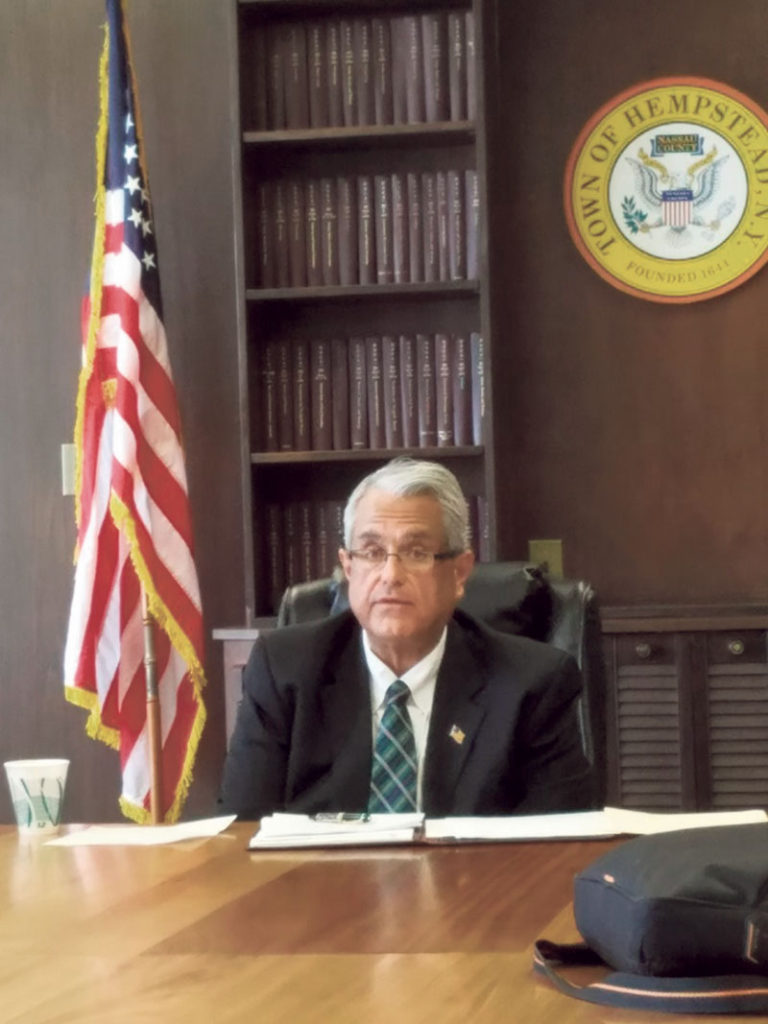Editor’s note: Town of Hempstead Supervisor Anthony Santino recently met with several community newspaper groups, including Anton Media Group, to talk about his 14-month tenure as the town’s chief executive officer.

When he took over on Jan. 1, 2016, said Santino, “There were significant financial challenges that we had to face and address. We had to cut costs without impacting services.”
Sometime this month, the town will close the books on the 2016 budget, and according to Santino, “We don’t know the actual numbers yet, but it will show significant impact of cost reduction efforts.”
The supervisor said that for years the town had been drawing heavily on reserves or surplus funds in order to fund operations. Though this came handy during the Great Recession, when the surpluses allowed the town to maintain services without raising taxes, it was not sustainable.
“Wall Street looks askance at that,” he noted. “You don’t need to be a math whiz to be able to understand that it’s something that you can’t do for very long. Expenses have to be lower than or at least equal to your income.”
The 2017 budget, the first that he crafted, is also “the first in at least 25 years that is structurally balanced, that is, it makes no use of reserve funds whatsoever.
“We anticipate adding to the surplus to be able to put money into the reserves,” Santino added, likening it to homeowners putting money into a rainy day fund. “The business cycle being what it is, there will be good times and bad times. A recession is always four, five or six years away, and you have to prepare for the lean years.”
According to Santino, the town cut overall spending by 3 percent year-to-year, and 2017 expenditures were budgeted to be slashed by $13.4 million compared to 2016. Both Moody’s and Standard & Poor’s have upgraded the credit rating outlook from “negative” to “stable” in recent months.
The town has cut overtime by 45 percent, translating to nearly a $2.5 million reduction in payroll expenses.
“We are reordering how we operate from the point of view of the workforce, like doing things on straight time and not overtime,” said Santino, who added that overtime had been endemic in all departments.
As an example, the town’s Stop Throwing Out Pollutants (STOP) program, held on Saturdays and Sundays, would be staffed with personnel who had worked Monday through Friday, thus accumulating extra pay. Now, anyone who will man the drop off station will work Tuesday through Saturday or Wednesday through Sunday so as to avoid time and a half.
In all, the 2017 budget cut $19 million from full-time workforce payroll.
Santino said there were two successful retirement incentives where positions were filled with newer people making a lot less money.
”A lot of the higher paid senior employees retired,” said Santino, adding, “We’re working harder and smarter. We’re delivering services with a significantly reduced workforce. Full-time employees have been cut by 6 percent and part-time employees were cut by 25 percent.”
Reconfiguring the sanitation routes saved $1.8 million.
Initiated under his predecessor Kate Murray but implemented under his watch, the town converted all street lights—about 50,000—to LED high efficiency. In 2016, this conversion saved $2.2 million; in the 20-year lifespan of the bulbs it’s expected to save $43 million.
The town will also change all of the lighting in the interior buildings to LED, and that’s expected to save $1.8 million.
This winter, the town began a pilot program using a combination of beet juice and brine to prepare roadways before snowstorms, and Santino claimed it was very effective. Brine is 80 percent water/20 percent salt. This combination cut salt usage by 80 percent. Beet juice, which is clear, makes the brine more effective. Traditional road salt, he related, has to be spread immediately before a storm or it loses its effectiveness. Brine can be sprayed up to 72 hours ahead of time, so if a storm is expected on a Saturday or Sunday, it could be put down as late as Friday, thus saving overtime costs.

Santino revealed that the town will open its September 11 Memorial in time for the next commemoration. It will be erected at Point Lookout Town Park.
“We’re very proud of our commemoration,” he said. “It’s the best attended on Long Island, and every year we have a somber, solemn, respectful program that is very well received. But the memorial was temporary and was taken down right after the ceremony.”
He went on to note that the town had many affected by 9-11, both on the day of the event and subsequently, with 9-11 related illnesses.
Santino thought the location will be ideal.
“We get thousands of people on our beaches each summer—and even outside the summer months, people go down there for peace and quiet and to run or walk on the beach,” he said. “So we have literally tens of thousands who use [the park] each year, and they will be reminded of the sacrifice and tragedy of 9/11 each time they go there.
“This means a lot to me personally,” he added.
Summing up his theory and practice of governance, Santino said, “I challenge people who work here every day with the same question: if this was your business, would you run it that way?”
































